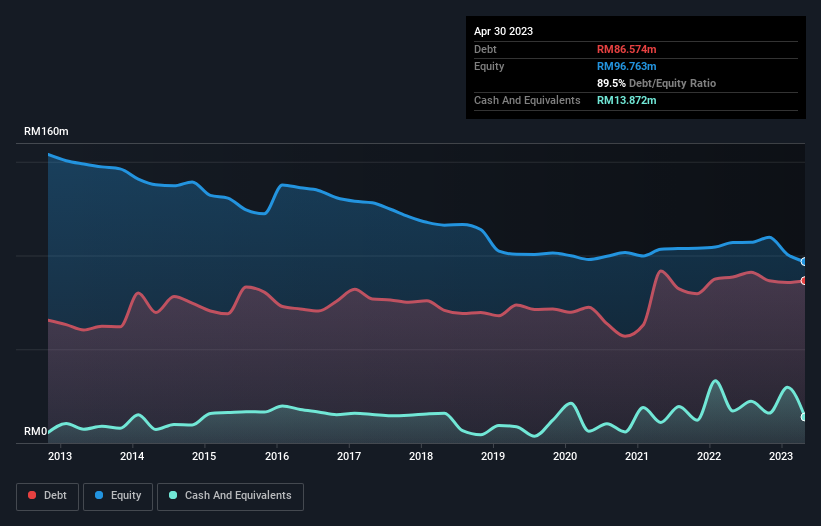- Malaysia
- /
- Basic Materials
- /
- KLSE:QUALITY
Would Quality Concrete Holdings Berhad (KLSE:QUALITY) Be Better Off With Less Debt?
Some say volatility, rather than debt, is the best way to think about risk as an investor, but Warren Buffett famously said that 'Volatility is far from synonymous with risk.' When we think about how risky a company is, we always like to look at its use of debt, since debt overload can lead to ruin. As with many other companies Quality Concrete Holdings Berhad (KLSE:QUALITY) makes use of debt. But the real question is whether this debt is making the company risky.
When Is Debt A Problem?
Debt and other liabilities become risky for a business when it cannot easily fulfill those obligations, either with free cash flow or by raising capital at an attractive price. In the worst case scenario, a company can go bankrupt if it cannot pay its creditors. However, a more usual (but still expensive) situation is where a company must dilute shareholders at a cheap share price simply to get debt under control. Having said that, the most common situation is where a company manages its debt reasonably well - and to its own advantage. When we think about a company's use of debt, we first look at cash and debt together.
View our latest analysis for Quality Concrete Holdings Berhad
How Much Debt Does Quality Concrete Holdings Berhad Carry?
The chart below, which you can click on for greater detail, shows that Quality Concrete Holdings Berhad had RM86.6m in debt in April 2023; about the same as the year before. However, because it has a cash reserve of RM13.9m, its net debt is less, at about RM72.7m.

How Healthy Is Quality Concrete Holdings Berhad's Balance Sheet?
According to the last reported balance sheet, Quality Concrete Holdings Berhad had liabilities of RM167.0m due within 12 months, and liabilities of RM12.9m due beyond 12 months. On the other hand, it had cash of RM13.9m and RM115.0m worth of receivables due within a year. So its liabilities total RM51.1m more than the combination of its cash and short-term receivables.
This deficit is considerable relative to its market capitalization of RM68.4m, so it does suggest shareholders should keep an eye on Quality Concrete Holdings Berhad's use of debt. Should its lenders demand that it shore up the balance sheet, shareholders would likely face severe dilution. There's no doubt that we learn most about debt from the balance sheet. But it is Quality Concrete Holdings Berhad's earnings that will influence how the balance sheet holds up in the future. So when considering debt, it's definitely worth looking at the earnings trend. Click here for an interactive snapshot.
In the last year Quality Concrete Holdings Berhad's revenue was pretty flat, and it made a negative EBIT. While that's not too bad, we'd prefer see growth.
Caveat Emptor
Over the last twelve months Quality Concrete Holdings Berhad produced an earnings before interest and tax (EBIT) loss. To be specific the EBIT loss came in at RM129k. Considering that alongside the liabilities mentioned above does not give us much confidence that company should be using so much debt. Quite frankly we think the balance sheet is far from match-fit, although it could be improved with time. For example, we would not want to see a repeat of last year's loss of RM7.9m. In the meantime, we consider the stock very risky. When analysing debt levels, the balance sheet is the obvious place to start. However, not all investment risk resides within the balance sheet - far from it. For example, we've discovered 2 warning signs for Quality Concrete Holdings Berhad (1 is a bit unpleasant!) that you should be aware of before investing here.
At the end of the day, it's often better to focus on companies that are free from net debt. You can access our special list of such companies (all with a track record of profit growth). It's free.
Valuation is complex, but we're here to simplify it.
Discover if Quality Concrete Holdings Berhad might be undervalued or overvalued with our detailed analysis, featuring fair value estimates, potential risks, dividends, insider trades, and its financial condition.
Access Free AnalysisHave feedback on this article? Concerned about the content? Get in touch with us directly. Alternatively, email editorial-team (at) simplywallst.com.
This article by Simply Wall St is general in nature. We provide commentary based on historical data and analyst forecasts only using an unbiased methodology and our articles are not intended to be financial advice. It does not constitute a recommendation to buy or sell any stock, and does not take account of your objectives, or your financial situation. We aim to bring you long-term focused analysis driven by fundamental data. Note that our analysis may not factor in the latest price-sensitive company announcements or qualitative material. Simply Wall St has no position in any stocks mentioned.
About KLSE:QUALITY
Quality Concrete Holdings Berhad
An investment holding company, manufactures, trades, and sells ready-mixed concrete and concrete products in Malaysia.
Slight risk and slightly overvalued.
Market Insights
Community Narratives





